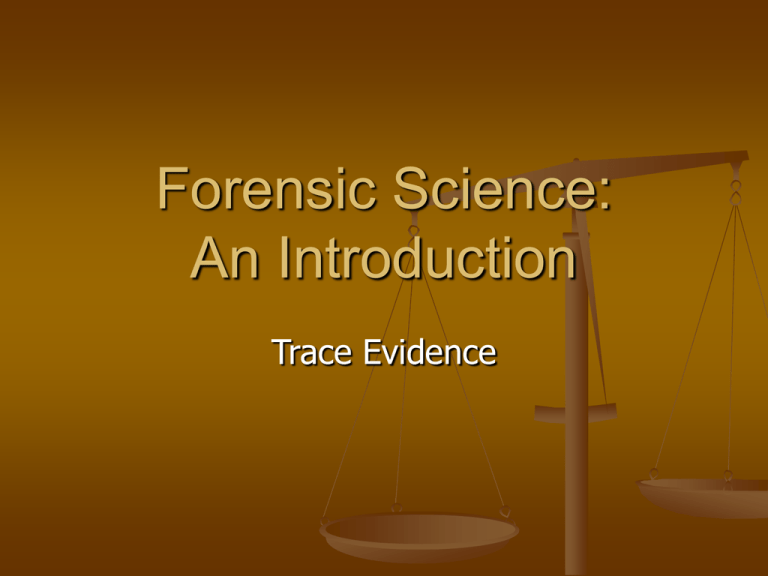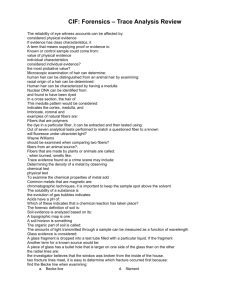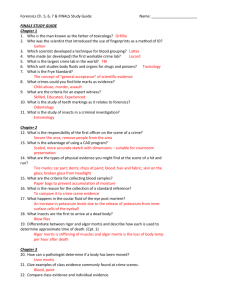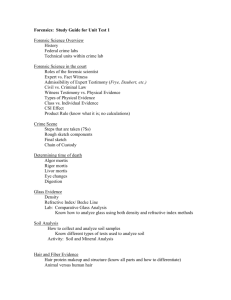Document
advertisement

Forensic Science: An Introduction Trace Evidence Properties of Matter Physical properties – describe the behavior of matter; can change without changing the composition of the matter (melting, solubility) Chemical properties – describes the behavior of matter in relation to other substances; if this property changes, then the substance has changed (gas production, precipitation, reactivity) Metric System Metric conversion English/Standard to Metric Conversions Nature of Matter Matter – anything that has mass and takes up space Element – simplest form of matter that cannot be broken down further by chemical means. (Periodic Table) Atom – smallest unit of an element that still retains the properties of that element Compound – a pure substance made up of two or more elements bound together States of Matter Solids – molecules of matter held very closely together; has definite shape and volume Liquid – molecules of matter held more loosely together by attractive forces; has definite volume but shape depends on container Gas – molecules of matter are allowed to freely move; has not definite volume or shape Changes in the States of Matter Freezing Melting Condensation Sublimation Evaporation Boiling Phase – a separation of different substances of matter due to visible boundaries between them Light as a Wave Wavelength – distance from crest to crest Frequency – number of waves that pass a given point Amplitude – how high the waves are Speed of light – wavelength x frequency Light as a Wave Dispersion – the separating light into its different component colors Refraction - the bending of light caused by a change in its velocity Reflection – the bouncing of light off a surface Transmission – the passing of light through a substance Absorption – the Electromagnetic Spectrum Light as a Particle Photon – a discrete packet or particle of electromagnetic radiation Each as a certain amount of energy related to its frequency such that E = hf h is Planck’s constant f is frequency Physical Properties of Matter Temperature – measure of heat intensity; average amount of molecular movement in a substance (Fahrenheit and Celsius) Weight – the force of gravity exerted on a substance; differs in the universe w = mg Mass – amount of matter an object has; a constant Density – mass of an object in relation to its volume; it remains the same regardless of the size of an object (intensive property) Physical Properties of Matter Refractive Index – the ratio of the speed of light in a vacuum to its speed of light in a given medium RI = velocity of light in vacuum velocity of light in medium Refractive index of water is 1.333 thus it travels 1.333 times as fast in a vacuum as it does in water Crystalline solids may have two refractive indeces (birefringence) while amorphous solids do not. Forensic Analysis of Glass Composition – amorphous solid of silicon mixed with other metal oxides Soda-lime glass – windows and bottles Sodium, calcium, magnesium, aluminum are common metal oxides added Borosilicates – boron is added to make heatresistance (headlights, Pyrex) Tempered – strengthened by heat/cool stress during manufacturing (car side windows) Laminated – two sheets of glass with plastic sheet in between (windshields) Forensic Glass Analysis Comparing fragments Flotation Refractive index comparison Classification of glass samples Glass fractures Concentric fracture Radial fracture 3R rule: Radial fractures form Right angles on the Reverse side of the force Collection and preservation of glass evidence Trace Evidence transferred between individuals and objects during the commission of a crime Often can corroborate other evidence Generally class characteristics and not individual characteristics Examples: Hair, Fibers, Metals, Paints, Soil, Glass, and Impressions Hair Morphology Hair follicle, Shaft, Tip end Cuticle – outer layer, keratinized scale structure, animal specific Cortex – main body of hair shaft, color Medulla – center; cellular column, medullary index Hair Growth Root is where the hair grows Anagen phase – initial growth phase, lasts up to six yrs, root attached to follicle, provides follicular tag; grows 1 cm per month Catagen phase – decreasing growth rate, 2-3 wks, Telogen phase – growth stops, 2-6 months, hair is shed Forensics of Hair Identification of animal hair Comparison of human hairs Color, length, diameter, medulla structure, cortex pigments Microscopic examination is presumptive while DNA is confirmative Standard/reference samples 50 full length head hairs 24 full length public hairs From hair, can we learn about… Body area origin? yes Racial origin? yes Age or sex? No Forcibly removed? Yes Individualize human hair? Yes, through DNA Fibers Natural fibers from animal or plant sources, cotton Manufactured fibers from natural or synthetic polymers Types of Fibers Acetate Acrylic Aramid Bicomponent Lyocell Melamine Modacrylic Nylon Olefin Polyester PBI Rayon Spandex Forensics of Fibers Microscopic examination of fibers Color, diameter, striation, pitting Microspectrophotometry Chemical composition Birefringerence Infrared absorption Metals Trace elements of less than 1% composition may provide invisible markers to help in comparisons Composition of Paint Electrocoat primer Primer surfacer Basecoat Clearcoat Forensics of Paint Microscopic Pyrolysis gas chromatography Infrared spectrophotometry Emission spectrophotometry Paint Data Query (PDQ) Soil Examination of soil content include natural and manufactured objects in it. Microscopic examination can identify minerals by color, shape, refractive index, or birefringence Density-gradient tubes determine the density distribution of soil Spectrophotometry determines soil settling Bullet and Cartridge Comparisons Gum barrel has grooves (rifling) to help spin the bullet The diameter of the bore of the barrel is called the caliber Various processes of creating rifling can be used to identify maker of gun Various processes of creating rifling all create striations that are unique to gun Bullet and Cartridge Comparisons The striation markings on the bullet can provide individual characteristics for gun comparison. FBI maintains a record known as the General Rifling Characteristics File which lists class characteristics for known weapons. Shotguns do not have rifling thus no striations. The size of the shotgun is referred to as its gauge. Cartridge casings also will have markings on it from the loading, firing or ejection mechanisms. Automated Firearms Search Systems DRUGFIRE developed by the FBI focused on the casings IBIS developed by the ATF focused more on the bullets NIBIN incorporates both systems Ballistic Fingerprinting of guns prior to sale is being discussed. Gunpowder Residues Incomplete combusted gun powder residue deposited on target allows for distance determination Without the weapon, generalizations can be made about the distance Melted clothing fibers and star shape hole – less than 1 inch away black smoke around hole – 12-18 inches away scattered specks around hole – 25 inches away only bullet wipe – greater 3 feet away Shotgun distances can be determined by the scatter of the pellets (1 inch scatter for every yard of distance) Gunpowder residues can be developed on clothing using chemical tests Gun Shot Residue Primer residue is propelled backward and deposited on the hand of the shooter GSR can be detected chemically or microscopically (SEM) Ballistics A bullet encounters four ballistic regimens Internal ballistics – primer and propellents Internal ballistics – movement throught the barrel; grooves and lands External ballistics – gravity, Coriolis effect, aerodynamic, Magnus force, yaw, ballistic coefficient Terminal ballistics – hitting the target; yaw, lacerations, crushing, cavitation Terminal ballistics Toolmarks Any impression, cut, gouge or abrasion caused by a tool coming into contact with another object. Typically, impression comes from prying action of tool Damage, wear patterns as well as manufactured striations may be left in impression Silicone casting material is used to create a cast of the impression for comparison with the suspected tool. The impression may also contain trace evidence such as paint from the tool. Other Impressions Shoe print Tire prints Fabric impressions Impression must be photographed, lifted or casted, and then compared Shoe and tire marks in soft earth can be casted Bitemarks can be casted Dust left on a floor can be lifted electrostatically Bloody footwear impression can be enhanced with chemical treatment. Document Examination Questioned document – any document which some issue has been raised or that is the subject of an investigation. Requires knowledge in microscopy, photography, and chromatography Handwriting Comparisons General style Variations in handwriting Angle, slope, speed, pressure, spacing, dimension, connections, pen movement, writing skill, finger dexterity, margins, spacing, alignment, phraseology, spelling, grammar Exemplars – an authentic sample for comparison purposes, such as handwriting Natural variations – normal deviations found between repeated specimens of an individual’s handwriting Typescript Comparisons Photocopier – random debris on the glass cover or machinery can be reproduced Fax machines – transmitting terminal identifier (TTI) font can be altered Computer printers – letter shape and toners may vary Typewriters – type face alignment will vary Alterations in Documents Erasure – removal of writing or printing from a document normally accomplished by either chemical or abrasive means Obliterations – blotting out or smearing over writing to make it unreadable Charred document – darkened and brittle by exposure to fire or heat Indented Writings – impressions left on paper positioned under a piece of paper that has been written on Ink and paper Comparisons Chromatography and ink tags allow comparison of ink Cellulose content, weight, color, watermarks, and additives vary in paper






